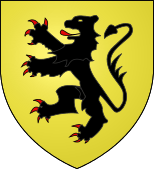States of Flanders

The States of Flanders were the representation of the three estates: Nobility, Clergy and Commons to the court of the Count of Flanders. These three estates were also called the States. Supported by the economic strength of the Flemish cities Bruges, Ghent and Ypres, the States always were an important power before the rulers of the country.
After the county of Flanders and all Seventeen Provinces of the Netherlands came under the rule of the dukes of Burgundy, the States of Flanders were the first host of the States-General of the Netherlands, on January 9, 1464 in Bruges.
In 1579–1580, during the Eighty Years' War, the cities and the States of Flanders joined Dutch independence declaration (Union of Utrecht and Act of Abjuration), but Spanish troops reconquered most of the Flemish territory and restored Spanish Catholic rule (except for Zeelandic Flanders).
On January 4, 1790, the States of Flanders again declared independence, this time from Austrian imperial rule, and seven days later, on January 11, 1790, joined the United States of Belgium. All Southern Netherlands "States" disappeared four years later, during French revolutionary occupation.